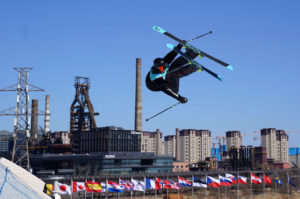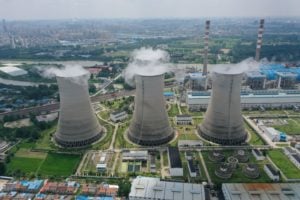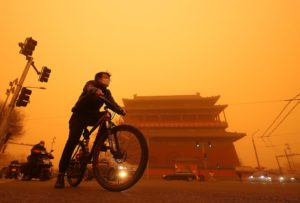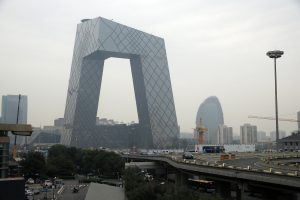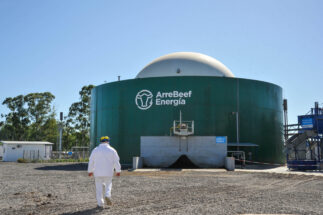Over the 14 years between the 2008 Summer Olympics and the recent winter games, the biggest change in people’s impressions of Beijing might be its gradually bluer skies. In 2008, many Chinese people couldn’t tell fog from smog, or say what PM2.5 pollution was. But now in 2022, no weather forecast is complete without data on PM2.5 – harmful fine particles less than 2.5 micrometres wide – while blue skies and fluffy white clouds are no longer a strange sight.
In 2013, information on PM2.5 was added to China’s annual reports on the state of its environment. A Ministry of Ecology and Environment report shows that average PM2.5 levels nationwide have since fallen from 72 micrograms (μg) per cubic metre in 2013 to 30 μg/m3 in 2021 – a 58% fall and a major improvement in air quality.
“The air people in Beijing breathe today is dramatically cleaner than it was during the last Olympics, allowing residents to live longer, healthier lives,” said Michael Greenstone, professor at the Energy Policy Institute at the University of Chicago (EPIC). “The speed of these reductions is without historical precedent globally.”
Recent research from EPIC says that China’s efforts on air pollution have accounted for three-quarters of the reduction in airborne pollutants worldwide, and, if sustained, will increase the life expectancy of its citizens.
From 2008 to 2022
There were notable changes in China’s approach to air pollution between the two Olympics. In 2008, targeted short-term measures were used to bring about a quick improvement in air quality. But in 2013, longer-term and more sustainable programmes were put in place, and air quality gradually improved – but at significant financial and social cost.
To ensure the 2008 Games were a “Green Olympics”, China took rapid, radical measures. These included shutting some chemical and cement factories near Beijing, and, for several weeks before, during and after the games, taking half of the city’s cars off the roads on any given day. According to a paper from 2013, China spent US$10 billion on these measures, and managed to bring air pollution in Beijing down by 29.6% during the games, compared with the previous year. The researchers described the feat as “the largest natural experiment in air cleaning” in Olympic history.
4.6 years
The average increase in life expectancy for residents of Beijing between 2013 and 2020 due to a drop in air pollutants, according to the study
But such efforts could not last long. In the following years, air pollution continued to worsen, peaking at its highest ever in 2013. According to EPIC’s data, average PM2.5 levels in Beijing in 2013 were 85 μg/m3 – almost 2.4 times the applicable national standard, and 17 times the World Health Organization (WHO) guideline.
Such severe air pollution has a huge impact on expected lifespans. Research published in the Proceedings of the National Academy of Sciences of the United States of America in 2017 pointed out that long-term exposure to particulate pollution causes significantly shorter lifespans, and a much higher chance of suffering heart and respiratory diseases.
In 2013, faced with worsening air pollution, China published an action plan to mobilise 1.7 trillion yuan (about $277 billion) in relevant investment. The aim was to reduce PM10 pollution in cities of prefecture-level or higher by 10% or more on 2012 levels by 2017; and to reduce PM2.5 levels in the populous Beijing-Tianjin-Hebei, Yangtze Delta and Pearl River Delta areas by 25%, 20% and 15% respectively. PM2.5 pollution in Beijing was to be kept to around 60 μg/m3. By 2017, these goals had been achieved.
In 2018, the government issued another action plan, this time on “winning the war to protect blue skies”. This toughened up the targets from the earlier action plan, setting new targets for reductions in sulphur dioxide and nitrogen oxides, as well as the number of good and poor air quality days a city should have.
To hit those targets, the Chinese government set about saving energy and reducing emissions in the coal power sector by upgrading and refitting power plants; and sped up efforts to get polluting vehicles off the country’s roads. It also encouraged ultra-low emissions refits for the steel industry and promoted the development of more environmentally friendly equipment for industry, particularly polluting industries.
Today, virtually every city in the country has much cleaner air than in 2008. According to the research published by EPIC, this means locals will benefit from longer life expectancy, provided China can maintain these improvements. Take Beijing and Shanghai as examples: between 2013 and 2020, Beijing saw PM2.5 levels go from 85 μg/m3 to 38 μg/m3, meaning an increase in life expectancy of 4.6 years. The change in Shanghai was from 50 μg/m3 to 28 μg/m3, and an increase of 2.2 years. Nationwide, the increase in life expectancy compared with 2013 is two years.
The researchers also pointed out China’s leadership role in tackling air pollution: it accounted for three-quarters of all reductions in air pollution over the 2013–2020 period. In contrast, air pollution is going up in South Asia: Bangladesh, India, Nepal and Pakistan have seen an average increase of 35% in levels of particulate pollution since the start of the century.
Keeping up the good work
China’s success in controlling air pollution means more blue skies – even when the Olympics aren’t in town. But the national average PM2.5 level of 30 μg/m3 is still six times higher than the WHO guideline of 5 μg/m3. Pollution in Beijing is still three times as bad as that in Los Angeles, the most polluted city in the US.
More worryingly, Beijing’s 2021 PM2.5 figure of 33 μg/m3 may only be down due to measures taken for the Winter Olympics. The nearby city of Tangshan, China’s biggest steel manufacturing centre, cut back on production from August last year to the conclusion of the games, with some firms simply shut down.
The policy costs are getting higher and higher, and there will be more and more obstacles to cutting emissions.
Will air pollution rebound as those measures are phased out? One of the authors of the report, He Guojun, says no. He told China Dialogue that China’s air quality will continue to improve, but less rapidly. “The policy costs are getting higher and higher, and there will be more and more obstacles to cutting emissions.”
The report points out that China incurred huge expenses during the first stage of the war on air pollution, as it overlooked the differing costs incurred by companies, industries and regions, and achieved its targets with no thought to reducing those costs. This left stakeholders resentful of environmental rules, with some local governments pushing back. “As China enters the next phase of its war against pollution, leaders may find it difficult to continue this swift decline in pollution,” said Ken Lee, the director of the Air Quality Life Index, an initiative of EPIC. “This points to an opportunity to change tactics from the tough, command-and-control policies that have worked over the last several years to lower-cost approaches that better align incentives, market structures and local realities.”
He Guojun says the national carbon market, officially launched in July last year, will help in reducing air pollution. He told China Dialogue that carbon dioxide emissions and air pollution both stem from the use of fossil fuels, so controlling carbon will result in improved air quality. That national carbon market is up and running in the energy sector, with carbon-intensive firms needing to buy up carbon quotas, or cut down on energy use. Low-carbon firms can sell the quotas they don’t need for a profit. This will help localities and industries make more economical cuts in emissions.
He Guojun added that environmental taxes could be used to prevent carbon markets simply resulting in the relocation of pollution to other areas of the country. “Carbon trading could result in pollution moving from places where the marginal costs of cutting emissions are higher, to places where they are lower. In China, that means developed areas may use carbon trading to improve local air quality, while it worsens in under-developed areas.” He went on: “Appropriate environmental taxes could be applied where that is happening, and I think that’s the next thing policymakers could consider.”
He Guojun also said that if China can build on its carbon trading system to create markets for other pollutants, with a cross-regional pollution trading system, it could see more targeted and less expensive reductions in emissions.
